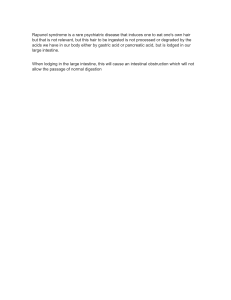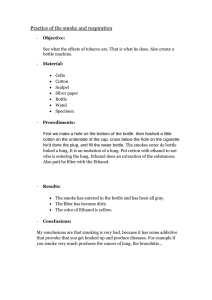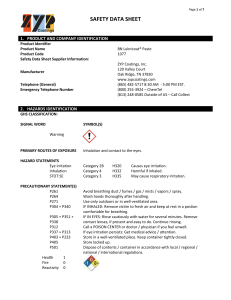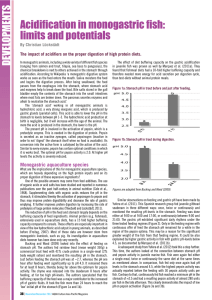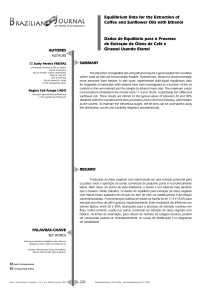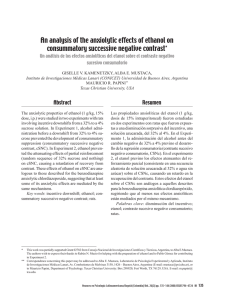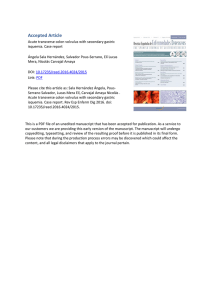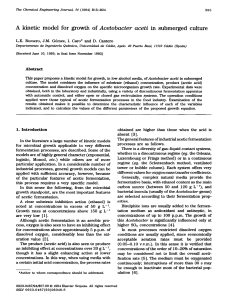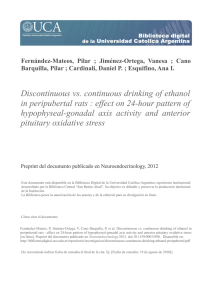Pharmacokinetics Effect of Diclofenac or Ketorolac-methyl Eugenol and Their Implication in the Gastroprotection
Anuncio
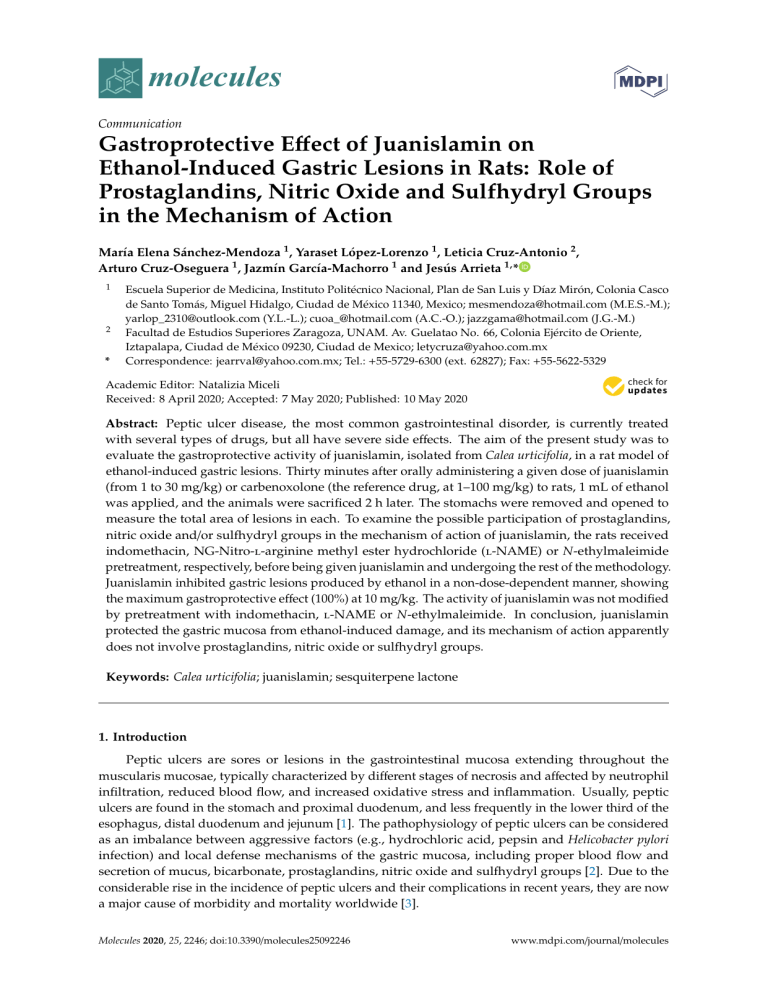
molecules Communication Gastroprotective Effect of Juanislamin on Ethanol-Induced Gastric Lesions in Rats: Role of Prostaglandins, Nitric Oxide and Sulfhydryl Groups in the Mechanism of Action María Elena Sánchez-Mendoza 1 , Yaraset López-Lorenzo 1 , Leticia Cruz-Antonio 2 , Arturo Cruz-Oseguera 1 , Jazmín García-Machorro 1 and Jesús Arrieta 1, * 1 2 * Escuela Superior de Medicina, Instituto Politécnico Nacional, Plan de San Luis y Díaz Mirón, Colonia Casco de Santo Tomás, Miguel Hidalgo, Ciudad de México 11340, Mexico; [email protected] (M.E.S.-M.); [email protected] (Y.L.-L.); [email protected] (A.C.-O.); [email protected] (J.G.-M.) Facultad de Estudios Superiores Zaragoza, UNAM. Av. Guelatao No. 66, Colonia Ejército de Oriente, Iztapalapa, Ciudad de México 09230, Ciudad de Mexico; [email protected] Correspondence: [email protected]; Tel.: +55-5729-6300 (ext. 62827); Fax: +55-5622-5329 Academic Editor: Natalizia Miceli Received: 8 April 2020; Accepted: 7 May 2020; Published: 10 May 2020 Abstract: Peptic ulcer disease, the most common gastrointestinal disorder, is currently treated with several types of drugs, but all have severe side effects. The aim of the present study was to evaluate the gastroprotective activity of juanislamin, isolated from Calea urticifolia, in a rat model of ethanol-induced gastric lesions. Thirty minutes after orally administering a given dose of juanislamin (from 1 to 30 mg/kg) or carbenoxolone (the reference drug, at 1–100 mg/kg) to rats, 1 mL of ethanol was applied, and the animals were sacrificed 2 h later. The stomachs were removed and opened to measure the total area of lesions in each. To examine the possible participation of prostaglandins, nitric oxide and/or sulfhydryl groups in the mechanism of action of juanislamin, the rats received indomethacin, NG-Nitro-l-arginine methyl ester hydrochloride (l-NAME) or N-ethylmaleimide pretreatment, respectively, before being given juanislamin and undergoing the rest of the methodology. Juanislamin inhibited gastric lesions produced by ethanol in a non-dose-dependent manner, showing the maximum gastroprotective effect (100%) at 10 mg/kg. The activity of juanislamin was not modified by pretreatment with indomethacin, l-NAME or N-ethylmaleimide. In conclusion, juanislamin protected the gastric mucosa from ethanol-induced damage, and its mechanism of action apparently does not involve prostaglandins, nitric oxide or sulfhydryl groups. Keywords: Calea urticifolia; juanislamin; sesquiterpene lactone 1. Introduction Peptic ulcers are sores or lesions in the gastrointestinal mucosa extending throughout the muscularis mucosae, typically characterized by different stages of necrosis and affected by neutrophil infiltration, reduced blood flow, and increased oxidative stress and inflammation. Usually, peptic ulcers are found in the stomach and proximal duodenum, and less frequently in the lower third of the esophagus, distal duodenum and jejunum [1]. The pathophysiology of peptic ulcers can be considered as an imbalance between aggressive factors (e.g., hydrochloric acid, pepsin and Helicobacter pylori infection) and local defense mechanisms of the gastric mucosa, including proper blood flow and secretion of mucus, bicarbonate, prostaglandins, nitric oxide and sulfhydryl groups [2]. Due to the considerable rise in the incidence of peptic ulcers and their complications in recent years, they are now a major cause of morbidity and mortality worldwide [3]. Molecules 2020, 25, 2246; doi:10.3390/molecules25092246 www.mdpi.com/journal/molecules Molecules 2020, 25, x FOR PEER REVIEW 2 of 9 proper 2020, blood Molecules 25,flow 2246 and secretion of mucus, bicarbonate, prostaglandins, nitric oxide and sulfhydryl 2 of 8 groups [2]. Due to the considerable rise in the incidence of peptic ulcers and their complications in recent years, they are now a major cause of morbidity and mortality worldwide [3]. The The therapeutic therapeutic strategies strategies for for managing managing peptic peptic ulcers ulcers are are based based on on eliminating eliminating pain, pain, healing healing ulceration, preventing recurrence, and, more recently, eradicating Helicobacter pylori. ulceration, preventing recurrence, and, more recently, eradicating Helicobacter pylori. The The drugs drugs administered these strategies are are classified according to their mechanism of action, being administeredtotocarry carryout out these strategies classified according to their mechanism of action, antacids, cytoprotectants and antisecretory agents [4]. Among latter, the promising treating being antacids, cytoprotectants and antisecretory agents [4].the Among themost latter, the mostfor promising + /K+ exchange pump. However, it has been shown that prolonged gastric ulcers are inhibitors of the H for treating gastric ulcers are inhibitors of the H+/K+ exchange pump. However, it has been shown use this type use of inhibitor (e.g., lead to a decreased of absorption vitamin B12, thatof prolonged of this type of omeprazole) inhibitor (e.g.,can omeprazole) can lead toabsorption a decreased of which in turn may result in dementia, neurological damage, anemia or other possibly irreversible vitamin B12, which in turn may result in dementia, neurological damage, anemia or other possibly complications. Additionally,Additionally, proton pump inhibitors been implicated acute myocardial irreversible complications. proton pumphave inhibitors have beeninimplicated in acute infarction [5] and pancreatic cancer [6]. The foregoing overview highlights the need to develop new myocardial infarction [5] and pancreatic cancer [6]. The foregoing overview highlights the need to types of gastroprotective therapies. develop new types of gastroprotective therapies. Medicinal Medicinal plants plants are are often often the the source source of of new new drugs. drugs. From From one one such such plant, plant, Calea Calea urticifolia, urticifolia, three three compounds with gastroprotective activity have been isolated and previously reported [7–9]. The compounds with gastroprotective activity have been isolated and previously reported [7–9]. aim The of theofpresent study study was towas evaluate the gastroprotective effect of effect juanislamin (PubChem CID 6440536), aim the present to evaluate the gastroprotective of juanislamin (PubChem CID isolated C. urticifolia, a rat model gastric lesions. gastric The mechanism of 6440536),from isolated from C.inurticifolia, in of a ethanol-induced rat model of ethanol-induced lesions. The action was explored by examining the possible participation of nitric oxide, prostaglandins and mechanism of action was explored by examining the possible participation of nitric oxide, sulfhydryl groups. prostaglandins and sulfhydryl groups. 2. 2. Results Results 2.1. Ethanol-Induced Gastric Lesions 2.1. Ethanol-Induced Gastric Lesions Oral administration of juanislamin (Figure 1; 1–30 mg/kg) reduced ethanol-induced gastric Oral administration of juanislamin (Figure 1; 1–30 mg/kg) reduced ethanol-induced gastric injury (Figure 2), inhibiting gastric lesions in a non-dose-dependent manner (Figure 3a). Maximum injury (Figure 2), inhibiting gastric lesions in a non-dose-dependent manner (Figure 3a). Maximum gastroprotection (100%) was achieved with the dose of 10 mg/kg. The gastroprotection provided gastroprotection (100%) was achieved with the dose of 10 mg/kg. The gastroprotection provided by by the dose of 3 mg/kg (93.32 ± 3.34%) was slightly lower but not significantly different, and that the dose of 3 mg/kg (93.32 ± 3.34%) was slightly lower but not significantly different, and that afforded at 1 mg/kg was 80.65 ± 6.16%. Carbenoxolone, on the other hand, exhibited dose-dependent afforded at 1 mg/kg was 80.65 ± 6.16%. Carbenoxolone, on the other hand, exhibited activity (Figure 3b), reaching the maximum gastroprotection at 100 mg/kg (86.06 ± 1.08%). Whereas dose-dependent activity (Figure 3b), reaching the maximum gastroprotection at 100 mg/kg (86.06 ± the protective effects produced by the doses of 30 and 10 mg/kg were 75.09 ± 3.76% and 56.6 ± 4.96%, 1.08%). Whereas the protective effects produced by the doses of 30 and 10 mg/kg were 75.09 ± 3.76% respectively, those furnished by the doses of 3 and 1 mg/kg were minimal. As can be appreciated, and 56.6 ± 4.96%, respectively, those furnished by the doses of 3 and 1 mg/kg were minimal. As can carbenoxolone appears to be less potent than juanislamin. be appreciated, carbenoxolone appears to be less potent than juanislamin. Figure1. 1. The The structure structure of of juanislamin. juanislamin. Figure Molecules 2020, 25, 2246 3 of 8 Molecules 2020, 25, x FOR PEER REVIEW Molecules 2020, 25, x FOR PEER REVIEW 3 of 9 3 of 9 Figure 2. Representative images ofimages gastric mucosal lesions in rats treated with (a) the(a) vehicle plus ethanol and and Figure 2. Representative gastricmucosal mucosal lesions with thethe vehicle plusplus ethanol Figure 2. Representative images ofofgastric lesionsin inrats ratstreated treated with (a) vehicle (b) juanislamin plus ethanol. (b) juanislamin plus ethanol. ethanol and (b) juanislamin plus ethanol. a) * * 100 * * 100 b) b) * * * * 80 80 60 40 40 60 40 Gastroprotection (%) 80 Gastroprotection (%) Gastroprotection (%) 60 a) 100 100 80 120 Gastroprotection (%) 120 * * 60 40 20 20 20 20 0 0 0 1 1 3 3 10 30 10 Dose (mg/kg) 30 0 1 1 3 3 10 30 100 100 10Dose 30 (mg/kg) Dose (mg/kg) Dose (mg/kg) In model the rat of model of ethanol-induced lesions, distinct of gastroprotection Figure 3.Figure In the3.rat ethanol-induced gastricgastric lesions, distinct levelslevels of gastroprotection resulted from different treatments: a) juanislamin (1–30 mg/kg) and b) carbenoxolone (1–100 Figure 3. In the rat model of ethanol-induced gastric lesions, distinct levels of gastroprotection resulted from different treatments: (a) juanislamin (1–30 mg/kg) and (b) carbenoxolone (1–100 mg/kg). mg/kg). Bars represent the mean ± SEM (n = 7). * p ≤ 0.05, Kruskal–Wallis test followed by Dunn’s resulted from different treatments: a) juanislamin (1–30 mg/kg) and b) carbenoxolone (1–100 Bars represent the mean ± SEM (n = 7). * p ≤ 0.05, Kruskal–Wallis test followed by Dunn’s multiple comparison. mg/kg). represent the mean ± SEM (n = 7). * p ≤ 0.05, Kruskal–Wallis test followed by Dunn’s multipleBars comparison. multiple comparison. 2.2. Participation of Prostaglandins, Nitric and Oxide and Sulfhydryl the Mechanism Action of 2.2. Participation of Prostaglandins, Nitric Oxide Sulfhydryl GroupsGroups in the in Mechanism Action Juanislamin of Juanislamin 2.2. Participation of Prostaglandins, Nitric Oxide and Sulfhydryl Groups in the Mechanism Action of Juanislamin The mechanism of action of juanislamin was explored by pretreatments with indomethacin (a The mechanism of action of juanislamin was explored by pretreatments with indomethacin prostaglandin inhibitor), NG-Nitro-L-arginine methyl ester hydrochloride (L-NAME, a nitric oxide (a prostaglandin inhibitor), NG-Nitro-l-arginine esterby hydrochloride a nitric oxide The mechanism of action of juanislamin wasmethyl explored pretreatments(l-NAME, with indomethacin (a synthase inhibitor) and N-ethylmaleimide (NEM, a blocker of sulfhydryl groups) [10]. The rats synthase inhibitor) and NG-NitroN-ethylmaleimide (NEM, a ester blocker of sulfhydryl groups) a[10]. The ratswere prostaglandin inhibitor), L-arginine methyl hydrochloride (L-NAME, nitric oxide pretreated with one of the aforementioned inhibitors and then ethanol was applied (without were pretreated with of the aforementioned then ethanol was[10]. applied (without synthase inhibitor) andone N-ethylmaleimide (NEM, ainhibitors blocker ofand sulfhydryl groups) The rats were administering the test or reference compound). The data reveal the lack of significant difference administering testoforthe reference compound). The data reveal lack ofwas significant pretreated withthe one aforementioned inhibitors and then the ethanol applied difference (without when comparing the ulcerof index of the control group ofreceiving rats receiving 0.05% Tween 80 plus ethanol when comparing the index the control group of rats 0.05% 80 plus ethanol administering testulcer or The data reveal the of Tween significant difference 2) to that compound). (83.33 the ± 11.26 mmreference found in animals pretreated withlack indomethacin (101 ± 5.16 mm2), 2 2 (83.33comparing ± 11.26 mmthe ) to that index foundof in the animals pretreated with (101Tween ± 5.16 80 mm ), l-NAME when ulcer control group ±of ratsindomethacin receiving plus ethanol 2) and 0.05% L-NAME2 (94.96 ± 3.46 mm2) or NEM (86.44 4.45 mm then given ethanol (Figure 4a–c). 2 (94.96 ± 3.46 mm ) or NEM (86.44 ± 4.45 mm ) and then given ethanol (Figure 4a–c). Therefore, 2 2 (83.33 ± Therefore, 11.26 mmthe ) togastric that damage found in animalsinpretreated (101 ± mm produced the present with studyindomethacin cannot be attributed to 5.16 any of the ),three gastric(94.96 damage produced present study cannot be any of the three inhibitors at 2) in 2) attributed Lthe -NAME ± at 3.46 orthe NEM (86.44 ± 4.45 mm and then to given ethanol (Figure 4a–c). inhibitors themm doses herein employed. the doses herein employed. Therefore, theIndependent gastric damage produced the present study cannot be attributed any of the three (70 groups of ratsinwere pretreated with indomethacin (10tomg/kg), L-NAME Independent groups of rats were pretreated with indomethacin (10 mg/kg), l-NAME (70 mg/kg) inhibitorsmg/kg) at the doses herein employed. or NEM (10 mg/kg), and subsequently treated with juanislamin (10 mg/kg) plus ethanol. or NEM (10 and subsequently treated with 9.68 juanislamin (100.0 mg/kg) plus resulting 2ethanol. Independent groups ofrates ratswere were pretreated with indomethacin LThe -NAME (70these Themg/kg), resulting ulcer 5.75 ± 1.47, ± 5.71 and ± 0.0(10 mmmg/kg), , respectively. Since 2 ulcer rates were 5.75 ± 1.47, and 9.68 ± 5.71from andthe 0.0 ± 0.0± with mm ,juanislamin respectively. these values 2 gastric damage values are significantly different 83.33 11.26 mm observed in the are control mg/kg) or NEM (10 mg/kg), subsequently treated (10Since mg/kg) plus ethanol. The resulting ulcer rates were 5.75 ± 1.47, 9.68 ± 5.71 and 0.0 ± 0.0 mm 2, respectively. Since these values are significantly different from the 83.33 ± 11.26 mm2 gastric damage observed in the control Molecules 2020, 25, 2246 4 of 8 significantly different from 83.33 ± 11.26 mm2 gastric damage observed in the control group Molecules 2020, 25, x FOR PEERthe REVIEW 4 of 9 of animals (vehicle plus ethanol), prostaglandin, nitric oxide and non-protein sulfhydryl are not involved animals (vehicle plus ethanol), prostaglandin, nitric oxide and non-proteinpretreatment sulfhydryl arewith in the group gastricofprotection of juanislamin (Figure 4a–c). Regarding carbenoxolone, not involved in the gastric protection of juanislamin (Figure 4a–c). Regarding carbenoxolone, each of the three inhibitors reversed its effect (Figure 4a–c), as evidenced by the respective ulcer indexes pretreatment with each of the three inhibitors reversed its effect (Figure 4a–c), as evidenced by the (79.76 ± 3.95, 86.11 ± 4.45 and 80.76 ± 3.95 mm2 ). These data are in agreement with reports in the respective ulcer indexes (79.76 ± 3.95, 86.11 ± 4.45 and 80.76 ± 3.95 mm2). These data are in literature [11]. agreement with reports in the literature [11]. 100 a) b) 100 80 Ulcer index (mm2) Ulcer index (mm2) 80 60 40 60 40 20 20 ** * 0 0 Vehicle C JA CAR Vehicle 100 C JA CAR L-NAME Indomethacin c) Ulcer index (mm2) 80 60 40 20 * 0 Vehicle C JA CAR NEM 4. Gastroprotective of juanislamin (JA, 10 mg/kg) and carbenoxolone (CAR, at 100 FigureFigure 4. Gastroprotective effecteffect of juanislamin (JA, at 10atmg/kg) and carbenoxolone (CAR, at 100 mg/kg) mg/kg) in rats receiving one of three pretreatments: (a) indomethacin (10 mg/kg), (b) in rats receiving one of three pretreatments: (a) indomethacin (10 mg/kg), (b) NG-Nitro-l-arginine methyl NG-Nitro-L-arginine methyl ester hydrochloride (L-NAME, 70 mg/kg) or (c) N-Ethylmaleimide ester hydrochloride (l-NAME, 70 mg/kg) or (c) N-Ethylmaleimide (NEM, 10 mg/kg). Comparisons were (NEM, 10 mg/kg). Comparisons were made to the negative control (vehicle + ethanol). C = different made inhibitors to the negative control (vehicle + ethanol). C = different inhibitors plus ethanol. Bars represent plus ethanol. Bars represent the mean ± SEM (n = 7). * p ≤ 0.05, Kruskal–Wallis test the mean ± SEM (n = 7). multiple * p ≤ 0.05, Kruskal–Wallis test followed by Dunn’s multiple comparisons. followed by Dunn’s comparisons. 3. Discussion 3. Discussion Gastric ulcers are characterized bybylesions mucosacaused caused alterations in the Gastric ulcers are characterized lesionsof ofthe the gastric gastric mucosa byby alterations in the balance between aggressive factors and local of theofgastric mucosa [12]. Tobacco smoking, balance between aggressive factors and protection local protection the gastric mucosa [12]. Tobacco the use of non-steroidal drugs (NSAIDs) and the consumption of alcohol are smoking, the use ofanti-inflammatory non-steroidal anti-inflammatory drugs (NSAIDs) and the consumption of the alcohol are the principal risk factors for gastric ulcers [13]. Since current treatments for this disorder principal risk factors for gastric ulcers [13]. Since current treatments for this disorder lead to serious side effects, great efforts have been made to find less toxic alternatives. In general, medicinal plants are an attractive source of new drugs. A plant with known gastroprotective activity, C. urticifolia [7–9], Molecules 2020, 25, 2246 5 of 8 was herein processed to isolate juanislamin, which was evaluated for gastroprotection in a model of ethanol-induced gastric lesions. Assays were carried out to explore the possible contributions of prostaglandins, nitric oxide and sulfhydryl groups in the mechanism of action of the compound under study. Gastric damage produced by ethanol involves many factors of imbalance, including the generation of free radicals and DNA damage, a decrease in the concentration of glutathione, and alterations in the mucus/bicarbonate layer [14]. Oral administration of juanislamin at all doses herein tested provided substantial protection against ethanol-induced gastric lesions, attaining 100% gastroprotection at 10 mg/kg (Figure 3a). Our group has previously described a similar effect with 2,3-epoxyjuanislamin, calealactone B and calein D (sesquiterpene lactones with a germacrane skeleton) also isolated from C. urticifolia [7–9]. However, these three compounds all showed potencies slightly lower than that of juanislamin. In all three cases, a dose of 30 mg/kg was required to reach 100% gastroprotection. Regarding the structural differences, juanislamin contains an additional α,β-unsaturated carbonyl group compared to the other three compounds. This moiety seems to have important biological activity. Prostaglandins protect the gastric mucosa by promoting mucus/bicarbonate secretion, maintaining blood flow and limiting acid secretion [15]. The possible participation of these compounds in gastroprotection is generally explored by using indomethacin, a prostaglandin inhibitor [7]. Since indomethacin pretreatment did not diminish the gastroprotection provided by juanislamin (Figure 4a), prostaglandins do not take part in its mechanism of action. Contrarily, indomethacin sharply reduced the gastroprotection of the reference drug, as observed in other studies [8]. Nitric oxide also plays a key role in the protection of the gastric mucosa by regulating blood flow in the tissue and significantly contributing to mucus/bicarbonate secretion [16]. The inhibition of nitric oxide synthesis found presently by the administration of L-NAME did not modify the gastroprotective activity of juanislamin (Figure 4b). Consequently, the mechanism of action of the test compound is not related to nitric oxide. For carbenoxolone, however, gastroprotection was notably decreased by l-NAME pretreatment, as previously reported [8]. Sulfhydryl groups protect the gastric mucosa by keeping the gastric mucus stable through the formation of disulfide bridges and the elimination of free radicals. The latter are capable of causing lipid peroxidation [17]. Following pretreatment with NEM in the current contribution, there was no significant change in the protection furnished by juanislamin against ethanol-induced gastric lesions (Figure 4c). Thus, the mechanism of action of gastroprotection does not involve sulfhydryl groups. Contrarily, the effect of carbenoxolone was reversed by NEM pretreatment, coinciding with published results. None of the three gastroprotective factors examined herein take part in the mechanism of action of juanislamin or the other three compounds isolated from C. urticifolia that have shown gastroprotective activity [7–9]. In one study, lactones isolated from C. urticifolia were found to bind to the sulfhydryl groups of the cysteine residues of the nuclear factor (erythroid-derived 2)-like 2 (Nrf2) system [18]. Interestingly, the products of omeprazole metabolism inhibit ATPase H+ /K+ by binding to its cysteine residues [19]. Hence, juanislamin may also bind to cysteine residues and trigger antioxidant protective activity or inhibit ATPase such as omeprazole. Further research is needed to explore the mechanism of action of this compound. 4. Materials and Methods 4.1. Animals Assays were carried out with 55- to 60-day-old male Wistar rats (180–220 g) provided by the Facultad de Estudios Superiores Zaragoza, UNAM. The animals were treated in accordance with the Official Mexican Norm for the Care and Handling of Animals (NOM-062-ZOO-1999) and international standards for the use of laboratory animals. They were housed in individual plastic containers and Molecules 2020, 25, 2246 6 of 8 given free access to food and water, except during the 24 h before experiments when food was removed. All experiments involved 7 animals per group and these were randomized for each treatment. 4.2. Drugs Carbenoxolone (PubChem CID: 636403, catalog number: C4790), NG -Nitro-l-arginine methyl ester hydrochloride (PubChem CID: 39836, catalog number: N5751), N-Ethylmaleimide (PubChem CID: 4362, catalog number: E3876) and indomethacin (PubChem CID: 3715, catalog number: I7378) were purchased from Sigma Chemical (St. Louis MO., USA). The compounds were freshly elaborated prior to each administration. 4.3. Isolation of Juanislamin The dichloromethane extract was prepared by macerating plant leaves (6.7 kg), as described by Sánchez-Mendoza et al. [10]. Column chromatography was performed with 300 g of the extract and an elution system based on hexane and mixtures of hexane/dichloromethane in various proportions. White crystals (1.5 g) were obtained from the fractions 80–90 (hexane/dichloromethane, 5:5) and identified as juanislamin (Figure 1) by comparing the 1 H- and 13 C-NMR spectra to those previously published [20]. Compound CID: 6440536, according IUPAC name: [(3aS,4S,5R,6R,8Z,10R,11aR)6-hydroxy-6,10-dimethyl-3-methylidene-5-(2-methylprop-2-enoyloxy)-2,7-dioxo-3a,4,5,10,11,11ahexahydrocyclodeca[b]furan-4-yl] 2-methylprop-2-enoate. 4.4. Ethanol-Induced Gastric Lesions Independent groups of rats were orally administered juanislamin or carbenoxolone (the reference compound) at different doses in a volume of 0.5 mL/100 g. Juanislamin was suspended in 0.05% Tween 80 and applied at 1–30 mg/kg. Carbenoxolone was dissolved in distilled water and delivered at 1–100 mg/kg. At 30 min post-treatment, 1 mL of ethanol was orally applied to all animals, regardless of weight. The animals were sacrificed 2 h later and the stomachs were immediately dissected, filled with 2% formaldehyde, and then placed in a container with the same solution for 5 min. Subsequently, each stomach was opened along the greater curvature and the area of the lesions was blindly measured by using a stereoscopic microscope (×10) equipped with an ocular micrometer. The sum of the area of the lesions of each stomach represents the ulcer index. Gastroprotection (%) was calculated according to: % gastroprotection = (UIC − UIT) × 100/UIC where UIC and UIT are the ulcer indexes of the control and experimental groups, respectively [21]. 4.5. Testing for the Participation of Prostaglandins To investigate the possible involvement of prostaglandins in the mechanism of action of juanislamin, three groups were subcutaneously injected with indomethacin (10 mg/kg) dissolved in saline solution with 5 mM NaHCO3 (0.1 mL/100 g) and one control group with the saline solution only (using the same route and volume). After 75 min, the following treatments were administered orally: Tween 80 (0.5%, 0.5 mL/100 g) to the control group and one of the indomethacin groups, as well as juanislamin (10 mg/kg) or carbenoxolone (100 mg/kg) to the other two indomethacin groups. At 30 min post-treatment, all animals were given 1 mL of ethanol and 2 h later were sacrificed. The stomachs were immediately dissected and processed (as previously mentioned) to determine the ulcer index. 4.6. Testing for the Participation of Nitric Oxide To examine the role of nitric oxide in the mechanism of action of juanislamin, three groups were intraperitoneally injected with L-NAME (70 mg/kg) dissolved in saline solution (0.1 mL/100g) and one control group with saline solution. After 30 min, the control animals and one of the l-NAME groups were administered Tween 80 (0.05%). The other two l-NAME groups were treated with juanislamin Molecules 2020, 25, 2246 7 of 8 (10 mg/kg) or carbenoxolone (100 mg/kg). At 30 min post-treatment, all animals were given 1 mL of ethanol and 2 h later were sacrificed. The stomachs were immediately dissected and processed (as previously mentioned) to determine the ulcer index. 4.7. Testing for the Participation of Sulfhydryl Groups To explore the possible contribution of sulfhydryl groups in the mechanism of action of juanislamin, NEM was subcutaneously injected (10 mg/kg dissolved in saline, 0.1 mL/100 g) to three groups of animals and saline solution to one control group. After 30 min, the control animals and one of the NEM groups were administered Tween 80 (0.05%). The other two NEM groups were treated with juanislamin (10 mg/kg) or carbenoxolone (100 mg/kg). At 30 min post-treatment, all animals were given ethanol and 2 h later were sacrificed. The stomachs were immediately dissected and processed (as previously mentioned) to determine the ulcer index. 4.8. Statistical Analysis Data are expressed as the mean ± SEM (n = 7). The statistical significance between treatments was examined by the Kruskal–Wallis test followed by Dunn’s multiple comparison test, with significance considered at p ≤ 0.05. 5. Conclusions In summary, the results from the evaluation of the gastroprotective activity of juanislamin reinforce the idea that sesquiterpene lactones with a germacrane skeleton could possibly be instrumental in the search for new drugs to treat gastric ulcers. Apparently, the mechanism of action of this type compound does not involve prostaglandins, nitric oxide or sulfhydryl groups. Author Contributions: M.E.S.-M., J.G.-M. and J.A. conceived and designed the experiments; Y.L.-L. and A.C.-O. performed the experiments; L.C.-A. analyzed the data and contributed to the preparation of the manuscript; M.E.S.-M. and J.A. were responsible for the writing, review and editing of the manuscript. All authors read and approved the final version of the manuscript. Funding: This research was supported by grants (SIP 20201001 and SIP 20200425) from the Escuela Superior de Medicina of the Instituto Politécnico Nacional, Mexico, and by PAPIITIN213918 from the DGAPA-UNAM, Mexico. Conflicts of Interest: The authors declare that they have no conflict of interests. Abbreviations NEM L-NAME NSAIDs SEM Nrf2 N-Ethylmaleimide NG-Nitro-l-arginine methyl ester hydrochloride Non-steroidal anti-inflammatory drugs Standard error of the mean Nuclear factor (erythroid-derived 2)-like 2 References 1. 2. 3. 4. 5. Ramakrishnan, K.; Salinas, R.C. Peptic ulcer disease. Am. Fam. Physician. 2007, 76, 1005–1012. Abdel-Salam, O.M.; Czimmer, J.; Debreceni, A.; Szolcsányi, J.; Mózsik, G. Gastric mucosal integrity: Gastric mucosal blood flow and microcirculation. An overview. J. Physiol. Paris. 2001, 95, 105–127. [CrossRef] Chow, D.K.; Sung, J.J. Non-NSAID non-H. pylori ulcer disease. Best Pract Res. Clin. Gastroenterol. 2009, 23, 3–9. [CrossRef] Sharifi-Rad, M.; Fokou, P.V.T.; Sharopov, F.; Martorell, M.; Ademiluyi, A.O.; Rajkovic, J.; Salehi, B.; Martins, N.; Iriti, M.; Sharifi-Rad, J. Antiulcer Agents: From Plant Extracts to Phytochemicals in Healing Promotion. Molecules 2018, 23, 1751. [CrossRef] [PubMed] Shah, N.H.; LePendu, P.; Bauer-Mehren, A.; Ghebremariam, Y.T.; Iyer, S.V.; Marcus, J.; Nead, K.T.; Cooke, J.P.; Leeper, N.J. Proton pump inhibitor usage and the risk of myocardial infarction in the general population. PLoS ONE 2015, 10, e0124653. [CrossRef] [PubMed] Molecules 2020, 25, 2246 6. 7. 8. 9. 10. 11. 12. 13. 14. 15. 16. 17. 18. 19. 20. 21. 8 of 8 Peng, Y.C.; Lin, C.L.; Hsu, W.Y.; Lu, I.T.; Yeh, H.Z.; Chang, C.S.; Kao, C.H. Proton pump inhibitor use is associated with risk of pancreatic cancer: A Nested Case-Control Study. Dose-Response. 2018, 16, 1559325818803283. [CrossRef] [PubMed] García-Martínez, L.E.; Sánchez-Mendoza, M.E.; Arrieta-Baez, D.; Cruz-Antonio, L.; Mejía-Barradas, C.M.; Soto-Perulero, C.R.; Arrieta, J. Gastroprotection of 2,3-epoxyjuanislamin, isolated from Calea urticifolia, against ethanol-induced gastric lesions in Wistar rats. Int. J. Pharmacol. 2016, 12, 893–900. Sánchez-Mendoza, M.E.; López-Lorenzo, Y.; Matus-Meza, A.S.; Arrieta, J. Gastroprotective effect of calealactone B: Lack of involvement of prostaglandins, nitric oxide and sulfhydryls. Drug. Dev. Res. 2018, 79, 11–15. [CrossRef] Sánchez-Mendoza, M.E.; López-Lorenzo, Y.; Cruz-Antonio, L.; Matus-Meza, A.S.; Sánchez- Mendoza, Y.; Arrieta, J. Gastroprotection of Calein D against Ethanol-Induced Gastric Lesions in Mice: Role of Prostaglandins, Nitric Oxide and Sulfhydryls. Molecules 2019, 24, 622. [CrossRef] [PubMed] Navarrete, A.; Arrieta, J.; Terrones, L.; Abou-Gazar, H.; Calis, I. Gastroprotective effect of Astragaloside IV: Role of prostaglandins, sulfhydryls and nitric oxide. J. Pharm. Pharmacol. 2005, 57, 1059–1064. [CrossRef] Vera-Arzave, C.; Antonio, L.C.; Arrieta, J.; Cruz-Hernández, G.; Velasquez-Mendez, A.M.; ReyesRamírez, A.; Sánchez-Mendoza, M.E. Gastroprotection of suaveolol, isolated from Hyptis suaveolens, against ethanol-induced gastric lesions in Wistar rats: Role of prostaglandins, nitric oxide and sulfhydryls. Molecules 2012, 17, 8917–8927. [CrossRef] [PubMed] Vidal, C.S.; Oliveira Brito Pereira Bezerra Martins, A.; de Alencar Silva, A.; de Oliveira, M.R.C.; Ribeiro-Filho, J.; de Albuquerque, T.R.; Coutinho, H.D.M.; da Silva Almeida, J.R.G.; Quintans, L.J., Jr.; de Menezes, I.R.A. Gastroprotective effect and mechanism of action of Croton rhamnifolioides essential oil in mice. Biomed. Pharmacother. 2017, 89, 47–55. [CrossRef] [PubMed] Awaad, A.S.; El-Meligy, R.M.; Soliman, G.A. Natural products in treatment of ulcerative colitis and peptic ulcer. J. Saudi.Chem. Socy. 2013, 17, 101–124. [CrossRef] La Casa, C.; Villegas, I.; Alarcón de la Lastra, C.; Motilva, V.; Martín Calero, M.J. Evidence for protective and antioxidant properties of rutin, a natural flavone, against ethanol induced gastric lesions. J. Ethnopharmacol. 2000, 71, 45–53. [CrossRef] Hawkey, C.J.; Rampton, D.S. Prostaglandins and the gastrointestinal mucosa: Are they important in its function, disease, or treatment? Gastroenterology 1985, 89, 1162–1188. [CrossRef] Kwiecien, S.; Pawlik, M.W.; Brzozowski, T.; Konturek, P.C.; Sliwowski, Z.; Pawlik, W.W.; Konturek, S.J. Nitric oxide (NO)-releasing aspirin and (NO) donors in protection of gastric mucosa against stress. J. Physiol. Pharmacol. 2008, 59 (Suppl. 2), 103–115. Rozza, A.L.; de Mello Moraes, T.; Kushima, H.; Nunes, D.S.; Hiruma-Lima, C.A.; Pellizzon, C.H. Involvement of glutathione, sulfhydryl compounds, nitric oxide, vasoactive intestinal peptide, and heat-shock protein-70 in the gastroprotective mechanism of Croton cajucara Benth. (Euphorbiaceae) essential oil. J. Med. Food. 2011, 14, 1011–1017. [CrossRef] Umemura, K.; Itoh, T.; Hamada, N.; Fujita, Y.; Akao, Y.; Nozawa, Y.; Matsuura, N.; Iinuma, M.; Ito, M. Preconditioning by sesquiterpene lactone enhances H2 O2 -induced Nrf2/ARE activation. Biochem. Biophys. Res. Commun. 2008, 368, 948–954. [CrossRef] Mejia, A.; Kraft, W.K. Acid peptic diseases: Pharmacological approach to treatment. Expert. Rev. Clin. Pharmacol. 2009, 2, 295–314. [CrossRef] Yamada, M.; Matsuura, N.; Suzuki, H.; Kurosaka, C.; Hasegawa, N.; Ubukata, M.; Tanaka, T.; Iinuma, M. Germacranolides from Calea urticifolia. Phytochemistry 2004, 65, 3107–3111. [CrossRef] Rojas-Martínez, R.; Arrieta, J.; Cruz-Antonio, L.; Arrieta-Baez, D.; Velázquez-Méndez, A.M.; Sánchez-Mendoza, M.E. Dillapiole, isolated from Peperomia pellucida, shows gastroprotector activity against ethanol-induced gastric lesions in Wistar rats. Molecules 2013, 18, 11327–11337. [CrossRef] [PubMed] Sample Availability: Samples of the compound juanislamin are available from the authors upon request. © 2020 by the authors. Licensee MDPI, Basel, Switzerland. This article is an open access article distributed under the terms and conditions of the Creative Commons Attribution (CC BY) license (http://creativecommons.org/licenses/by/4.0/).
